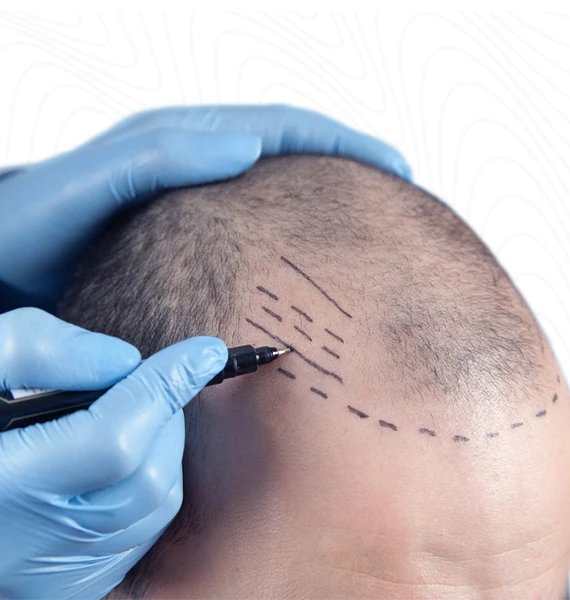Hair transplantation is the surgical procedure of taking permanent hair from the back of the head and using it to replace lost hair in the front of the head. This article will introduce you to the concept and give you some basic information on the procedure.
How is hair transplant possible?
Hair transplantation is a surgical procedure designed to restore or enhance hair growth in areas where hair has been lost or thinned. The process involves moving hair follicles from a donor site, typically the back or sides of the head, to the recipient site, which is the area where hair loss or thinning is a concern. The basic principle of hair transplantation is that of donor dominance – that the occipital area consists of androgen-resistant hairs and are therefore permanent – and they retain this property when transplanted to other areas. Hence, these hairs are retained even after being transplanted and do not fall off.
How can I cover such a large area from the hair on the back of my head?
The donor area in the occipital scalp is smaller than the potential bald area, hence a smaller area of donor’s hair is available to be used to cover a much larger recipient site. Therefore, what is done in any hair transplantation is to create an illusion of hair, to cover the bald area. It is never possible to create the same original density that the patient had. The logic behind this seemingly imbalanced equation needs to be well understood in order to understand the possibilities and limitations of this procedure. It is important to note that even though the total number of hairs on the head doesn’t change, their arrangement gives the impression of not being bald.

Some terms to understand in hair transplantation:
Follicular Units/Grafts– Hairs occur on your scalp in naturally occurring bunches called follicular units which can consist of anywhere from 1 to 4 hairs.
Calculating cost – Each follicular unit on average in Indians consists of 2.2 hairs. It is important to transplant these units as they exist and not break them down further to ensure their survival. For this reason, all discussion on number of transplants, and cost of hair transplants should be done in terms of grafts, and not hairs.
How is Hair transplantation done?
There are 3 basic steps:
- Harvesting grafts from the donor area
The first step of hair transplantation is the extraction of hair follicles or grafts from the donor area, typically located on the back or sides of the head. This donor area is chosen because the hair follicles in this region are typically genetically resistant to the hormone responsible for pattern hair loss (dihydrotestosterone or DHT).
There are two main methods of harvesting grafts:
- Follicular Unit Transplantation (FUT): In this method, a strip of skin is taken from the back of your head, which is sutured closed. This strip is dissected into grafts under a microscope.
- Follicular Unit Extraction (FUE): In this method, grafts are individually harvested one by one from the back of your head instead of taking an entire piece of skin.
To know the exact cost for FUE or FUT procedure for your case, please plan a consultation with us. This allows us to take a look at the area of hair loss & available donor area. You can contact us through our website.
- Creating holes in the recipient area
The next step involves creating tiny incisions or holes in the recipient area, which is the region where the hair loss or thinning is of concern. These incisions are strategically made in a way that mimics the natural hair pattern, ensuring an aesthetically pleasing and natural result. The angle and direction of these incisions are crucial to achieving a seamless look.
- Implanting grafts into these holes
The harvested grafts are then meticulously implanted into the recipient incisions created in the previous step. Surgeons carefully place the grafts, paying attention to the size and hair orientation to achieve a natural appearance. Single-hair grafts are typically used at the front hairline for a soft and natural look, while larger grafts provide density in areas behind the hairline.
How are holes made for the hair transplant?
The hairline is designed in consultation with the patient, we design the hairline to be as natural as possible. Creating the recipient sites or holes for hair transplant is a critical step in the procedure, and it requires precision and artistry to achieve an aesthetically pleasing result. We distribute the grafts in a CUSTOMIZED MANNER. We place the single hair grafts in the front to give beauty and larger grafts in the back to give volume. This gives a better result.
Implanting the hair transplant grafts
This is done by a team of 3 people to give the best result. There are a few factors to consider:
- The hairs have to go in quickly, the longer they stay out the lesser chance of survival.
- The grafts have to be handled as carefully as possible and not be damaged.
- The grafts have to be spaced appropriately and follow the design of the customized hairline.
The final results become more visible after 6 to 12 months. To conclude, hair transplant surgery is a common and effective method for addressing hair loss, and it can provide a permanent solution for many individuals. The success of a hair transplant depends on various factors, including the surgeon’s skill, the quality of donor hair, and the patient’s individual characteristics. It is very possible to receive a natural and aesthetically pleasing result, but it’s important to have realistic expectations.
